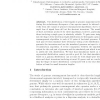2407 search results - page 457 / 482 » The evolutionary forest algorithm |
RECOMB
2005
Springer
14 years 10 months ago
2005
Springer
Reticulation events occur frequently in many types of species. Therefore, to develop accurate methods for reconstructing phylogenetic networks in order to describe evolutionary his...
RECOMB
2004
Springer
14 years 10 months ago
2004
Springer
The distribution of the lengths of genomic segments inverte during the evolutionary divergence of two species cannot be inferred d rectly from the output of genome rearrangement al...
ISBRA
2009
Springer
14 years 4 months ago
2009
Springer
A tanglegram is a pair of trees on the same set of leaves with matching leaves in the two trees joined by an edge. Tanglegrams are widely used in biology – to compare evolutiona...
KDD
2007
ACM
14 years 4 months ago
2007
ACM
Mixture models form one of the most widely used classes of generative models for describing structured and clustered data. In this paper we develop a new approach for the analysis...
AIED
2005
Springer
14 years 3 months ago
2005
Springer
SuperDuperWalker is a software-based framework for experiments on the evolution of locomotion. It simulates the behavior of evolving agents in a 3D physical simulation environment ...


